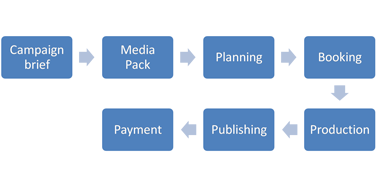Advertising E-commerce Specifications
The AdsML Framework of E-commerce Business Standards (“AdsML Framework”) is a set of standards and best practices that enable organizations and their vendors to implement e-commerce communications for the buying, selling, delivering, receiving, invoicing and paying of advertisements.
All of the standards in the Framework share both an e-commerce philosophy and a common set of design principles; they use common names and structures; and they support a common message choreography (i.e. the pattern by which e-commerce messages are exchanged between trading partners). AdsML aims to support all kinds of advertising, in all media and through all stages of the lifecycle of an advertisement. The AdsML Framework supports this goal by providing a component architecture within which key structures can be specialised to meet specific media requirements. The current release provides ‘generic’ structures that can be used for all media and provides specialised support for print and interactive digital media. Each release of the Framework contains the latest versions of all of the publicly available AdsML materials. The current release includes standards for:
- Exchanging product and pricing information (rate cards and media packs) between media buying systems and selling systems – AdsML Media Pack.
- Exchanging booking information (orders, reservations and/or quotations) between media buying systems and selling systems – AdsML Bookings.
- Exchanging financial information (invoices and credit notes) between the seller’s and payer’s financial systems – AdsML Financials.
- Delivering digital ad materials (e.g. a PDF, JPG, MP3, etc.) to one or more publishers accompanied by metadata that facilitates copy chasing and processing, or providing information about a delivery – AdsML Materials.
- Embedding a digital ad ticket inside a PDF or other form of digital artworkartwork and providing job metadata – AdsML Ad Ticket.
- Delivering proof of publication (e.g. an e-tearsheet) to a payer, accompanied by metadata that facilitates invoice reconciliation – AdsML Proof of Publication.
- Delivering information about the performance of an advertisement, including details about when, where, how and to whom it was published – AdsML Proof of Publication.
- Conveying a machine-processable description of the contents of an advertisement (that is, the products or services described in the ad) in a media-independent format – AdsML Structured Descriptions.
- Transmitting any form of digital information between two or more trading partners – AdsML Envelope.
Technical overview
Technically, the AdsML Framework provides a generic business process model and XML language by which business partners can exchange advertising data in a standardized message format and workflow. The AdsML business process model – the Advertising Components Interactions Analysis (ACIA) – models the end-to-end advertising workflow, defining core business processes and the messaging interactions required to support those processes, from campaign planning through to ordering, materials delivery, reporting proof, and invoicing.

In every one of the identified phases, AdsML provides a generic workflow model where the message flow for each information exchange is identified, named and described. Specific AdsML standards have been developed for individual process phases, providing the message formats needed to exchange information at each step of the process flow. The AdsML standards are XML-based and are designed to support a request-response messaging model that enables e-commerce. To support usage scenarios where request-response messaging is not possible and for specific workflows where it is not needed, a datagram ‘broadcast’ message model is also supported.
